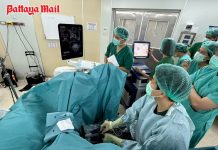How many people have told you that they have a slipped disc? Would you be one? Would you believe me that nobody “slips” a disc?
I was reminded about back problems when I was rung by a Norwegian doctor holidaying in Hua Hin. A friend of his had sudden onset acute lower back pain, could not stand on one leg and just where did they go from there?
These symptoms we meet only too often. The patient is doing something and suddenly everything locks up and they are immobilized, frozen to the spot. I was once called out to a factory toilet where the chap was bent over the urinal, and too afraid to move, the pain was so acute.
Back pain is one of the commonest orthopedic problems, and the often used terms such as lumbago, sciatica and slipped disc get bandied about at the dinner table. However, an acute bad back is not the sort of condition that you want to chat about over desserts. The condition can be crippling and not “cute” in any way.
Let’s begin this week with the “slipped disc” problem. First thing – discs do not “slip”. They do not shoot out of the spaces between the vertebrae (the tower of cotton reels that makes up your spine) and produce pain that way. The disc actually stays exactly where it is, but the center of the disc (called the nucleus) pops out through the edge of the disc and hits the nerve root. When this happens you have a very painful condition, as anyone who has had a disc prolapse (our fancy name for the “popping out” bit) will tell you. Think of the pain when the dentist starts drilling close to the tiny nerve in your tooth. Well, this is a large nerve! When the nucleus of the disc hits the sciatic nerve, this produces the condition known as Sciatica – an acute searing pain which can run from the buttocks, down the legs, even all the way through to the toes.
Unfortunately, just to make diagnosis a little difficult (if it were all so easy why would we go to Medical School for six years!) you can get sciatica from other reasons as well as prolapsing discs. It may just be soft tissue swelling from strain of the ligaments between the discs, or it could even be a form of arthritis. Another complicating fact is that a strain may only produce enough tissue swelling in around 12 hours after the heavy lifting, so you go to bed OK and wake the next morning incapacitated. And then you have to convince the employer that you did it on his time.
To accurately work out just what is happening requires bringing in those specialist doctors who can carry out extremely intricate forms of X-Rays called CT Scans, Spiral CT’s or MRI that will sort out whether it is a disc prolapse, arthritis or another soft tissue problem. The equipment to do these procedures costs millions of baht, and the expertise to use them takes years of practice and experience. This is one reason why some of these investigations can be expensive.
After the definitive diagnosis of your back condition has been made, then appropriate treatment can be instituted. The forms of treatment can be just simply rest and some analgesics (pain killers), physiotherapy, operative intervention or anti-inflammatories and traction.
Now perhaps you can see why it is important to find the real cause for your aching back. The treatment for some causes can be totally the wrong form of therapy for some of the other causes. You can see the danger of “self diagnosis” here. Beware!
So what do you do when you get a painful back? Rest and paracetamol is a safe way to begin. If it settles quickly, then just be a little careful with lifting and twisting for a couple of weeks and get on with your life as normal. If, however, you are still in trouble after a couple of days rest, then it is time to see your doctor and get that definitive diagnosis. You have been warned! There is a branch of the Bangkok Spine Academy in my hospital.




